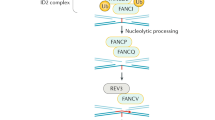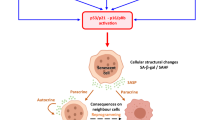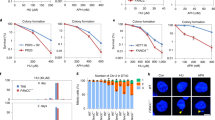Abstract
FANCONI'S anaemia (FA) is a rare autosomal recessive disease of man, characterised by a progressive hypoplastic pancytopenia associated with diverse congenital anomalies1,2, spontaneous chromosome breakage3 and predisposition to leukaemia and other cancers4,5. Lymphocytes from FA patients were found to be excessively susceptible to chromosome breakage by di- or polyfunctional alkylating agents6,7, and this was interpreted as a possible indication of defective DNA repair of the FA cells7. Seeking evidence for this, I have tested lymphocytes from FA patients for their chromosome response to mono- and difunctional mitomycins in relation to the cell cycle phase at the time of treatment, and have found that FA cells have a specific defect in the repair of pre-aberration lesions induced by difunctional mitomycin; the lesions are possibly DNA cross links of the interstrand type. The rationale of this experiment was the knowledge that if damage to DNA is left unrepaired it can be linked causally to the formation of chromosome aberrations by a process that resides in semi conservative DNA replication8–12. Since the repair of DNA damage is a rate-limiting process, the treatment of repair-proficient cells in early G1 would leave more time for repair before the damage is fixed into chromosome aberrations during the S phase, and consequently would result in fewer chromosome aberrations than treatment during the transition from G1 to S. In the repair-deficient cells, however, DNA damage induced by treatment in any position of G1 would be linked maximally to the formation of chromosome aberrations.
This is a preview of subscription content, access via your institution
Access options
Subscribe to this journal
Receive 51 print issues and online access
$199.00 per year
only $3.90 per issue
Buy this article
- Purchase on Springer Link
- Instant access to full article PDF
Prices may be subject to local taxes which are calculated during checkout
Similar content being viewed by others
References
Fanconi, G., Jb. Kinderheilk., 117, 257–281 (1927).
Gmyrek, D., and Syllm-Rapoport, I., Zeitschr. Kinderheilk., 91, 297–337 (1964).
Schroeder, T. M., Anschütz, F., and Knopp, A., Humangenetik, 1, 194–196 (1964).
Schroeder, T. M., and Kurth, R., Blood, 37, 96–112 (1971).
Swift, M. R., Nature, 230, 370–373 (1971).
Schuler, D., Kiss, A., and Fábián, F., Humangenetik, 7, 314–322 (1969).
Sasaki, M. S., and Tonomura, A., Cancer Res., 33, 1829–1836 (1973).
Bender, M. A., Bedford, J. S., and Mitchell, J. B., Mutation Res., 20, 403–416 (1973).
Griggs, H. G., and Bender, M. A., Science, 179, 86–88 (1973).
Sasaki, M. S., Mutation Res., 20, 291–293 (1973).
Stich, H. F., Stich, W., and San, R. H. C., Proc. Soc. exp. Biol. Med., 142, 1141–1144 (1973).
Scott, D., and Bigger, T. R. L., Chromosome Today, 3, 162–176 (1972).
Cleaver, J. E., Nature, 218, 652–656 (1968); Cancer Res., 33, 362–369 (1973).
Stich, H. F., San, R. H. C., and Kawazoe, Y., Nature, 229, 416–419 (1971).
Cole, R. S., Biochim. biophys. Acta, 217, 30–39 (1970); 254, 30–39 (1971).
Cole, R. S., Proc. natn. Acad. Sci. U.S.A., 70, 1064–1068 (1973).
Howard-Flanders, P., and Lin, P. -F., Genetics (Suppl.), 73, 85–90 (1973).
Shaeffer, J., and Merz, T., in Molecular and Cellular Repair Process (edit. by Beers, R. F., Jr, Herriott, R. M., and Tilghman, R. C.), 174–181 (Johns Hopkins University Press, Baltimore, 1972).
Reid, B. D., and Walker, I. G., Biochim. biophys. Acta, 179, 179–188 (1969).
Klimek, M., Photochem. Photobiol., 5, 603–607 (1966).
Boyce, R. P., and Howard-Flanders, P., Z. Vererbungsl., 95, 345–350 (1964).
Lawley, P. D., and Brookes, P., Nature, 206, 480–483 (1965); Biochem. J., 109, 433–447 (1968).
Author information
Authors and Affiliations
Rights and permissions
About this article
Cite this article
SASAKI, M. Is Fanconi's anaemia defective in a process essential to the repair of DNA cross links?. Nature 257, 501–503 (1975). https://doi.org/10.1038/257501a0
Received:
Accepted:
Issue Date:
DOI: https://doi.org/10.1038/257501a0
This article is cited by
-
The Fanconi anemia pathway and DNA interstrand cross-link repair
Protein & Cell (2011)
-
Guest editorial: fanconi anemia and the DNA damage response
International Journal of Hematology (2011)
-
Functional relationships of FANCC to homologous recombination, translesion synthesis, and BLM
The EMBO Journal (2005)
-
Chromosomal breakage, endomitosis, endoreduplication, and hypersensitivity toward radiomimetric and alkylating agents: A possible new autosomal recessive mutation in a girl with craniosynostosis and microcephaly
Human Genetics (1993)
-
The Chinese hamster V79 cell mutant V-H4 is phenotypically like Fanconi anemia cells
Somatic Cell and Molecular Genetics (1990)
Comments
By submitting a comment you agree to abide by our Terms and Community Guidelines. If you find something abusive or that does not comply with our terms or guidelines please flag it as inappropriate.



